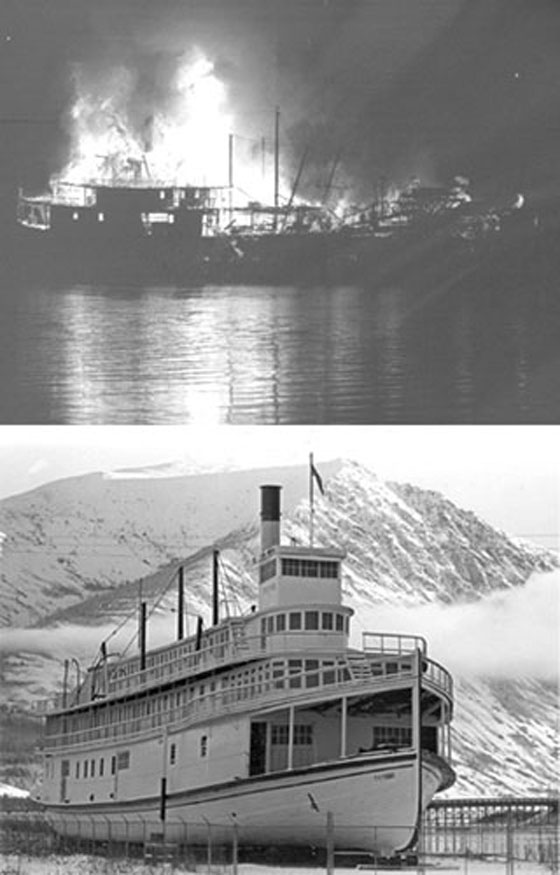
Photo by Whitehorse Star
Top: A LANDMARK FALLS - Flames roar through the S.S. Tutshi in Carcross early today. The vessel first started plying northern lakes in 1917. Photo by Stewart Breithaupt. Bottom: S.S. Tutshi before the fire. Star photo.

Photo by Whitehorse Star
Top: A LANDMARK FALLS - Flames roar through the S.S. Tutshi in Carcross early today. The vessel first started plying northern lakes in 1917. Photo by Stewart Breithaupt. Bottom: S.S. Tutshi before the fire. Star photo.
It’s a “black day” for the Yukon as people throughout the territory today mourn the loss of an irreplaceable piece of their history after the 73-year-old sternwheeler Tutshi burned to the ground early this morning in Carcross.
“It’s particularly bad for the people of Carcross, who feel like they’ve lost a family member,” Jeff Hunston, director of the Yukon government’s heritage branch, said in an interview this morning.
“It’s also a major blow to the economy. We’re going to recover – Yukoners always do – but it’s a pretty tough blow to absorb.”
Hunston and fellow heritage branch employees are reeling in shock today. They spent a better part of their working lives and more than $1 million to preserve the sternwheeler that plied the waters of the Southern Lakes district from 1917 to 1955, when it was retired in Carcross.
Loree Stewart, a heritage technician who spent countless hours carefully restoring the wooden vessel, is “devastated,” Hunston said. She drove to Carcross this morning with historic sites coordinator Doug Olynyk to assess the damage.
“They’ll see what’s retrievable but, obviously, there’s not much – maybe a few of the larger metal pieces” Hunston said despondently. “There’s more than a few tears across the territory.”
Arson, he said, is suspected, although the real causes of the fire won’t be known until after the Fire Marshal has submitted his report.
“One can speculate all one wants... but let’s just say it doesn’t look good.”
The heritage branch was just in the process of installing a new fire suppression system in the Tutshi, Hunston said. But even if a sprinkler system was fully operational, once a fire broke out in the tinder-dry boat, “It would be like spitting on a volcano.
“These boats are so old and so dry that if you get a good fire going, there’s not much you can do about it. And the linseed oil used in preservation and the paints only make things worse... Bingo, it’s gone – there’s just no hope.”
The vessel was equipped with fire hoses and extinguishers. But Hunston said they’re only effective if there’s personnel on board to detect a fire in its early stages.
And that leads to the heart of the problem – there are no resources available to the heritage branch to keep a 24-hour security watch over historic sites.
All Hunston can do is try to educate the public about the importance of preservation and the responsibility to ensure the yukon’s heritage is there for future generations to enjoy.
The loss of the Tutshi “really illustrates the vulnerability of our heritage – it’s under siege on all fronts. But people take it for granted. They go to bed at night and expect it to be there the next morning.
“The question is, is the public willing to spend the dollars to have people at these sites? It’s too late once it’s gone.”
Devastating fires – accidental and deliberate – have claimed more than their share of the Yukon’s heritage, he said. The sad list includes the Whitehorse and the Casca paddlewheelers in Whitehorse.
The Whitehorse Star, Wednesday, July 25, 1990
In order to encourage thoughtful and responsible discussion, website comments will not be visible until a moderator approves them. Please add comments judiciously and refrain from maligning any individual or institution. Read about our user comment and privacy policies.
Your name and email address are required before your comment is posted. Otherwise, your comment will not be posted.
Be the first to comment